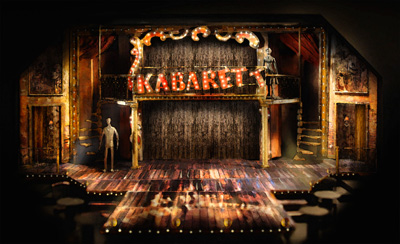Behind-the-Scenes of A Christmas Carol
For every production at Cygnet Theatre, we hold special Designer Forums that take our patrons behind-the-scenes with the creative team. Listen to the director of each show talk about how they prepare for a show, and get a glimpse into the process of set design, costumes, sound, & lighting. Check out our latest forum for A Christmas Carol.
Want to attend the next one? Make sure you’re on our e-blast list to get invitations and reminders.
Director’s Insight:
Creating the Characters: Costumes & Wigs
The Stage: Set Design
Creative Puppetry
The Magic of Mixing Live & Recorded Sound Effects
Where the Beauty Began…
We had a chance to sit down with award-winning Set Designer Sean Fanning to find out what inspired him to create our fabulous and glamorous set for PAGEANT. A Resident Artist, this marks his twentieth production with Cygnet over the past 9 years.
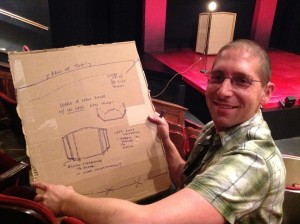
What are some of your favorite Cygnet shows/sets?
My first show with Cygnet was The Matchmaker, when I was a fresh-faced graduate student back in the 2006/2007 season. My most favorite collaborations include the re-imagining of the musicals Sweeney Todd, Cabaret, and Parade. Those three sets felt like characters of their own, but at the same time had an openness and changeability that allowed for so much interactive range. A personal favorite aesthetically was the Louse Nevelson inspired collage we did for The Norman Conquests during the 2010 season. The economy and focus of that design is something I still look back on fondly.
What do you like about working with Cygnet?
I love the sense of artistic freedom, which goes hand in hand with the challenges inherent in each production. The company’s collective vision is really about finding new ways to tell stories and for me this is also about taking risks as a designer. The thrust stage space of the Old Town Theatre presents a character and personality that cannot help but be reflected in the design approach, often in surprising and very invigorating ways.
How did you get into set design in the first place?
I’ve always loved art, loved drawing, and everything about architecture. And I had a real interest in seeing live theatre, which my mother really supported by making sure I got to see lots of it. Interestingly, it was my profound hearing loss that would make me focus more on the set, because I often couldn’t hear or comprehend the actors, I would spend lots of time looking at and thinking about the environment. The sets that really supported the story and characters were the most successful ones. In high school, while attempting to be some kind of actor, I found myself assigned to the scenery crew, and I haven’t looked back since. I bought books, taught myself drafting and scene painting. I was determined to make a future out of it. More than anyone else, I owe my career to a person who saw that potential in me, my drama teacher, Jack DeRieux, from Northgate High School in Walnut Creek, CA.
Where did you find your inspiration for the Pageant set?
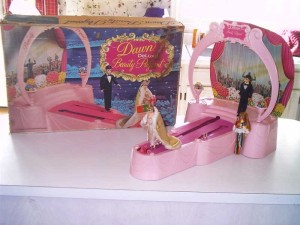 Initially, we knew we wanted to have a “stage within a stage,” some sort of portal within the Cygnet space with a stairway as the dominant visual. Early on in discussions with director James Vasquez, I was researching beauty pageants of the 1970’s and 1980’s – we were focused on a very rich era for both fashion and pageantry. The original goal was “cable access meets Lawrence Welk.” Much of what I found was downright tacky to modern eyes. Sill, there was a certain childlike innocence and playfulness that I really wanted to capture. It was when I stumbled upon an eBay listing for a late-70’s Dawn Deluxe Beauty Pageant toy set that I knew I had our inspiration. It was just this iconic, plastic little princess-pink portal with a little runway. I took the shape and the proportion and blew it up to life size, and really amped up the color saturation and boldness so it felt right to the piece.
Initially, we knew we wanted to have a “stage within a stage,” some sort of portal within the Cygnet space with a stairway as the dominant visual. Early on in discussions with director James Vasquez, I was researching beauty pageants of the 1970’s and 1980’s – we were focused on a very rich era for both fashion and pageantry. The original goal was “cable access meets Lawrence Welk.” Much of what I found was downright tacky to modern eyes. Sill, there was a certain childlike innocence and playfulness that I really wanted to capture. It was when I stumbled upon an eBay listing for a late-70’s Dawn Deluxe Beauty Pageant toy set that I knew I had our inspiration. It was just this iconic, plastic little princess-pink portal with a little runway. I took the shape and the proportion and blew it up to life size, and really amped up the color saturation and boldness so it felt right to the piece. 
What is unique, unusual, different, challenging or surprising about this set?
I think the most unique and surprising is the level of intimacy in this set. It feels very interactive, very “live.” James and I have focused on keeping the majority of the action out on the thrust stage. Very little of the action will be lost to audience seated along the sides. It has created some very dimensional opportunities for choreography, and I think it’s very exciting way to use the space.
How have you collaborated with other companies on this production? Is that helpful spirit the norm in San Diego?
We had some great help from the San Diego Opera’s scenic shop. We also had support from Joey Landwehr at J* Company, who let us use a set of silver curtains for our front swags. There definitely is a wonderful sense of community and support in San Diego when it comes to getting sets produced. In the past, we have also used the Old Globe and there is also a “loan-out” network amongst the smaller theatre companies, for props and scenic elements.
Final thoughts?
Perhaps one of my favorite aspects of this design is the “rebranding” we did for Glamouresse, the fictional beauty product corporation that has sponsored the pageant. The fonts and brand colors can be seen in nearly every scenic design element and prop. I started 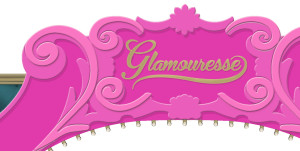 with this very iconic “G” and the script logo with “swoop” soon followed. It was inspired by the Revlon advertising done in the late 70’s and 80’s, but given
with this very iconic “G” and the script logo with “swoop” soon followed. It was inspired by the Revlon advertising done in the late 70’s and 80’s, but given 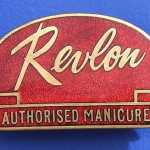 a certain saccharine color sense to offset any elegance. Bold pinks, metallic gold, with an aqua accent color. Props designer Michael McKeon followed suit with his marvelous designs for the various beauty wares that are hawked by the “spokesmodels” throughout the show. It was a very fun collaboration.
a certain saccharine color sense to offset any elegance. Bold pinks, metallic gold, with an aqua accent color. Props designer Michael McKeon followed suit with his marvelous designs for the various beauty wares that are hawked by the “spokesmodels” throughout the show. It was a very fun collaboration.
The Set Design of Cabaret: Part 2
You Just Can’t Cheat!
What can I say about executing a set at the Theatre in Old Town? It’s not your everyday scene shop. As I pull up to the parking lot next to the theatre, I find myself peering over the rustic fence at the lumber racks, sawhorses, and various bits of flats from old productions. This is the shop, where the thermostat seems to vary as much as San Diego weather, and the paint takes eons to dry on a damp day, or dries too quickly in the hot sun. And the rain is a constant threat that can set us back days at a time!
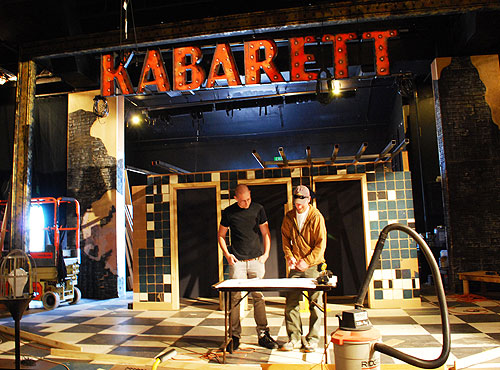 The talented team of carpenters under Technical Director Andy Scrimger use the yard behind the theatre to pre-build our scenery in parts. It’s a tricky planning process, due to a few approaches we use on our sets, which I’ll get to in a moment.
The talented team of carpenters under Technical Director Andy Scrimger use the yard behind the theatre to pre-build our scenery in parts. It’s a tricky planning process, due to a few approaches we use on our sets, which I’ll get to in a moment.
Andy began working with Cygnet in 2009, and has consistently been one to balance the needs of the budget with the demands of quality. Any technical director would tell you this is not an easy task. These days, we work together to implement strategies towards putting up a set by being very frugal, and as a byproduct (and a constant goal) using green, sustainable methods of creating scenery. Continue reading
The Set Design of Cabaret: Part 1
Cabaret as an Alcoholic Beverage
Last year, Sean Murray asked me to work with him on Sweeney Todd. It was our seventh production together. Working with Sean and co-director James Vasquez was
possibly the most freeing experience that can be asked of a designer for a musical theatre setting: we threw out all preconceived notions of the staging, we started from scratch and found our own voices in the piece.
And I discovered that doing a musical on a thrust stage means that, despite the amount of decorative flourishes I may apply to a setting, my eye always becomes inexorably riveted to the performer. Out there on that thrust surrounded on three sides by a rapt audience, and commanding a story. In one breathless moment, I can forget about everything I’ve been hired or trained to do as a designer, as I sit back and watch energy flow. Continue reading
Mauritius; Scary, Funny and Suspenseful
Yesterday was our first preview for Mauritius. It’s always exciting for me when we open a new production but I especially get excited when the audience really get’s into a show. Last night was no exception. There was plenty of gasping and nervous laughter, just what you hope for with a suspenseful thriller.
All of us at Cygnet were pretty excited to assemble such a great cast. Three of the principal characters in Mauritius worked together previously in our 2007 production of Communicating Doors. Communicating Doors was such a fun production and these actors have a wonderful chemistry together. Manny Fernandes once again plays the guy everyone is afraid of, and Sandy Campbell and Jessica John play the eccentric half sisters. Rounding out the cast is John DeCarlo, last seen in Cygnet’s production of Bug and Jack Missett from Cygnet’s Curse of the Starving Class of a few years back. The characters in Mauritius are pretty quirky and the actors have tapped into their characters perfectly. I think the actors are going to have a lot of fun with this one.
The production is staged by Cygnet Associate Artistic Director, Fran Gercke. Fran gets great support from the spot-on design team of Jessica John (yes, she’s also doing the costumes), Eric Lotze (lighting), Matt Lescault-Wood (sound), Bonnie Durben (props) and Sean Fanning (set). I do love it when all of the components come together so nicely and click. I just can’t wait for the theatre goers to come out and see it for themselves.
Mauritius is a San Diego premiere and one of the newest plays by Theresa Rebeck, one of Broadway’s hottest playwrights. We’re so excited to have been able to secure the rights to this one. Mauritius runs at the Cygnet Rolando stage through May 10th.
Bed and Sofa: the latest stage
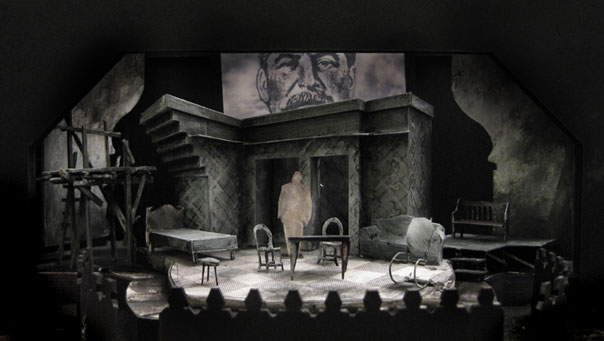
Andy Hull’s set model for Bed and Sofa.
Today we had our first formal design meeting for our upcoming Bed and Sofa. This is our first opportunity for all of the designers to get together and begin thinking about how all of our design choices are coming together. We want the ultimate product to have a cohesion, so that all of the various elements, each designed by different people, feel like they all belong to the same “world” that we are creating for the play.
As I wrote in an earlier post, the world of Bed and Sofa is that of the silent film. Since the original film was created in Moscow in 1926, we know that the look of the costumes, scenery and props will have a Soviet influence. Since we are trying to capture the feel of a silent film, we are setting the show in a world that is entirely seen in shades of grey, white and black.
Today, Andy Hull the set designer working with me on the show, presented his model of the set. We use this model as the first stage of the over all look. We can make changes on it still, but that time is now coming towards an end, as Nick Fouch, our technical director, now begins to turn the drawings and model into full size pieces made from real wood! Changes really begin to become difficult and expensive.
Here is a photo of Andy’s model. You can compare it to my first sketch. My idea for the set design came from the film. The apartment in the movie is a basement apartment and you can see the underside of the stairs jutting into the room. I liked the shape and tried to tie it in. In the musical the presence of Stalin is felt somehow as a looming Big Brother type. So we played with how to bring him into the design. I handed Andy this sketch and he has been working his magic on it. He cleaned it up and more importantly he added his wonderfully clever touches to it. The back masking flats, which will have collages of various images mentioned in the show, have the silhouette of the onion domes of St. Peters suggested in their shapes. Andy’s great.
We’ll keep you up on the progress.
